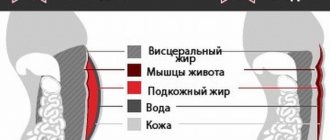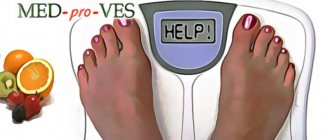Poor nutrition
Poor nutrition is the most common cause of this problem. Eating junk food and fatty foods reduces metabolism and increases waist size. Refined foods, white bread and baked goods, and pasta can cause poor digestion and the appearance of folds of belly fat. In addition, high-calorie foods can directly contribute to the accumulation of fat in the upper abdomen.
Subcutaneous fat
One of the most unpleasant problems is excessive accumulation of subcutaneous fat. In the waist and hips, the amount of subcutaneous fat is usually maximum, which affects our appearance.
When it comes to health, subcutaneous fat is the safest type. However, if your belly is too large and prevents you from performing simple activities such as walking, running, climbing stairs, or if you cannot sleep peacefully due to excessive amounts of fat, you need to urgently begin the process of losing weight.
To get rid of the problem, you should exercise regularly and follow the principles of proper nutrition. Strength and cardio exercises, as well as eliminating junk food from your diet will help you reduce the amount of subcutaneous fat and transform your figure.
Lack of exercise
25 children of a childless man: an extraordinary reunion
Paralympian Talay without arms and legs: “the harder the fight, the greater the victory”
A broken nail is no problem: tips for treating nails at home
A sedentary lifestyle is one of the main reasons that cause uncontrolled weight gain. Exercise is considered an important component of a healthy lifestyle, and little or no exercise contributes to fat gain.
Stress
Stress is a fairly common cause of weight gain. We often don't realize that the extra pounds we add are due to stress. It stimulates the body to release cortisol, which causes the liver to release excess sugar. But the body does not need such an amount, because it is not able to metabolize it all.
Because of this excess sugar, the body feels constantly hungry and we are forced to consume more food, especially foods high in sodium. This promotes the formation of fat folds in the described part of the body.
What is in the human body
Today, in the female consciousness (and even in the male consciousness), the very word “fat” causes a shudder - fat is harmful, extra pounds, centimeters, cellulite. Such a stereotype of perception, implanted in our minds, can seriously harm.
Everyone is no longer even losing weight, but drying as much as they can, in the hope of completely destroying the fat layer in the body.
Before we rush to study weight loss tips , let's understand the “fat issue” based on the facts and debunking the prevailing prejudice.
First of all, fat is the main source of vital energy, a “carrier” of vitamins, a “guardian” of the most important internal organs, the basis of heat exchange and metabolism. This means that a healthy body must have a certain percentage of fat, otherwise we will simply die.
Fat is always divided into 3 types:
Types of fat: functions and benefits
- Visceral.
The fat that is found around our organs is called visceral and is not visible to the naked eye, although its excess expands the waist from the inside.
Visceral deposits are important for the body because... protect organs from the influences of the internal environment. However, it is important that their total volume does not amount to more than 10-15% of the total number of all fat cells in the body.
- Subcutaneous. It is logical that this is the fat which accumulates under the skin, it is visible and palpable quite clearly.
About 40-60% of all body fat is subcutaneous fat - that soft fat that can be touched through the skin. Burning such fat is possible only when the level of visceral fat has returned to normal.
- By gender or abdominal – allocated to a separate group, because in men and women, excess is especially actively deposited in different places: around the abdomen and back in men (“apple-shaped”), and in the lower abdomen and hips in women (“pear-shaped type”).
Fat in these parts of the body is stored by the body for use only as a last resort. This is why it is so difficult to get rid of it.
Why is it dangerous?
There is such a thing as “visceral obesity” - these are exclusively those cases when fat is localized around internal organs. And the higher the degree, the more the risk of disease increases.
Accumulation of internal fat in excess of the prescribed norm is already becoming hazardous to health. Excess visceral fat can cause a number of the following diseases:
- varicose veins , as there is excessive stress on the legs,
- myocardial infarction , since the heart, covered with this fat, begins to malfunction,
- fatty hepatosis , dangerous due to intoxication, as bile formation and detoxification are impaired,
- stagnation of urine, formation of stones, development of infectious and inflammatory processes due to obesity of the kidneys, which impairs urinary function,
- visceral obesity of the pancreas causes disruptions in the digestive system ,
- oncological diseases - this is proven by a study published in the Archives of Internal Medicine. Increase in waist, i.e. Visceral obesity also increases the chances of dying from cancer, respiratory failure and other causes.
The fact is that excessive fat around the abdominal organs is associated with inflammation, high cholesterol, risk of diabetes and other problems.
The experiment by Eric J. Jacobs and his colleagues from the American Cancer Society in Atlanta involved 48.5 thousand men and 56.3 thousand women over the age of 50 years. During the study period (1997 to 2006), 9,315 men and 5,332 women from this group died.
Scientists were most surprised by the results among women who did not have weight problems. It was in this category that the relationship between waist size and mortality risk was greatest.
“If you're at the right weight for your height,” says Dr. Jacobs, “but your waist size is increasing and you're moving up a dress size, that's a warning sign that it's time to start eating healthier and exercising more. Even a small reduction in waist size, an inch or two, can be quite beneficial."
By measuring your waist using a tape measure, you can determine whether you are at risk. The norm is 90 cm for men and 75 cm for women. Regarding overweight people, the conclusion of American scientists is this: extra 30 cm in men and 32 cm in women doubles the risk of death.
As for women with normal weight, the research results are completely stunning. Every extra 10 cm in the waist increases the likelihood of acquiring a fatal disease by about 25%.
- Hormonal imbalance. Few people think about the fact that adipose tissue is the largest endocrine organ in the human body. It takes part in the processes of synthesis, accumulation and metabolism of hormones.
For example, visceral fat produces female sex hormones estrogens, or rather the enzyme “aromatase”. This enzyme "converts" the male hormone testosterone into the female hormone estradiol .
You probably know that it is testosterone that makes a man a man. The volume of muscle mass, libido, and potency depend on it. Therefore, in men with “beer bellies” the percentage of muscle mass decreases, erections worsen, and breasts grow.
These people are often referred to as “fat” or “woman’s figure.” But this enzyme also does not bring anything particularly good to women.
A similar process is the risk of tumors of the female genital organs and mammary gland.
- Visceral fat provokes the development of type 2 diabetes.
- Visceral fat hormones increase blood pressure. Because some of them regulate vascular tone and water-salt metabolism. The complex relationship between these hormones and other proteins that visceral fat also produces leads to increased blood pressure.
This is why losing weight for every 5 kg is so effective in reducing blood pressure in obese people.
A couple more important facts. Scientists say that the accumulation of visceral fat in adults does not depend or is determined by genetics, but is the result of an increase in the total amount of fat in the body .
The accumulation of visceral fat begins in men from 20.6% body fat and above, in women - from 39.4% and above.
Normal for women and men
A normal waist circumference is considered if it does not exceed 80 cm in women and 94 cm in men.
How to determine the level
So how do you measure the amount of internal fat a person has? There are several ways, it is better, of course, to check them all:
- To calculate the probability of visceral obesity, you need to determine the coefficient using the formula: waist circumference in cm divided by hip circumference in cm.
Important point : for a slender person, the waist is measured at the narrowest point, while for a fuller person, the measurement is made 2 cm above the navel. The volume of the hips should be measured at their widest part, regardless of body type.
With this measurement, a ratio of less than 0.85 for women and less than 1 for men is considered normal. Indicators above these values indicate the presence of abdominal-visceral obesity.
Of course, not all of it is visceral fat, some of it will be subcutaneous. To see exactly how much is visceral, measure your belly when you stand up and when you lie down. Subcutaneous fat will be “distributed” on the sides, but visceral fat will remain in the abdominal area.
- You can also check your visceral fat by calculating your waist to height ratio. A ratio of less than 0.5 for men and women is considered normal. Waist circumference should be less than half the person's height.
- Bioimpedance analysis of the body is, of course, the most accurate and reliable, but, to be honest, not so necessary.
Health problems
Seven daily habits of happy people
Sometimes we wear a bra incorrectly: ways that are harmful to health
When toothpaste is harmful to children: permissible age doses
The appearance of folds of fat on the abdomen can cause health problems. Digestive tract diseases, cardiovascular diseases, and hormonal imbalances such as Cushing's syndrome can lead to abdominal obesity. Sometimes, certain medications such as steroids, which are prescribed to treat certain diseases, also cause abdominal obesity.
Genetic predisposition
A person's genetic history of obesity may also be a major factor in the appearance of wrinkles. Many people have a genetic predisposition to obesity.
Removing folds of belly fat is not so easy. With so many reasons listed above, in order to get rid of belly fat, you will have to make drastic lifestyle changes. There are several steps you need to take, be sure to follow a strict diet to burn off all those belly folds.
The following are steps to help you get rid of unnecessary fat.
Does salon cosmetology help get rid of the “lifebuoy” effect?
Progress does not stand still, and modern technology today offers many means to combat fat on the sides.
The most effective and efficient remedy is LPG massage. For this, a special apparatus is used, which is “equipped” with rollers and a vacuum chamber. These products lift and knead unnecessary fat deposits. As a result, you get tightened contours and elastic skin. The procedure still has some disadvantages:
- It is extended over time. To “reduce” one size, you will need 15-20 sessions
- This brings up the issue of cost. The service is quite expensive. Now imagine how much these 20 sessions could cost you
Another achievement of cosmetologists is ultrasonic cavitation (what a scary word). It also does a great job of removing unnecessary deposits on the stomach and sides, getting rid of cellulite, and making the skin toned and elastic. And there are no downsides here:
- This procedure is also very expensive
- After it, it is advisable to also do a lymphatic drainage massage.
- Complications and side effects may occur
Oh, girls, this is all kind of complicated. But a beautiful figure without protruding barrels is worth it. Now get rid of them, show off in a new dress and you can relax again. But seriously, all these measures will only be effective if taken in an integrated manner. It is also important to make this a way of life, and not a seasonal phenomenon.
Beauty and health to you, my dears. Subscribe to my blog and be sure to share with your friends on social networks.
Strict diet
Diet is also a major factor that can help you get back into shape. You need to adhere to proper nutrition for a long time so that you become slim and healthy again. Eat often, but eat less food, don't eat too much food in one sitting, and don't overload your digestive system.
Replace high-calorie foods with lighter, healthier, nutrient-dense foods that won't harm your waistline. Avoid fatty and unhealthy foods such as chips, baked goods, cookies and sweets, and replace them with salads made with fresh fruits and vegetables.
You have a magnesium deficiency
People who don't get enough of this valuable macronutrient from their diet experience physical consequences in the form of increased blood glucose levels and higher insulin levels. You may not attribute these symptoms to a lack of magnesium, which is a key chemical element in the body that performs up to 300 different functions. There is a good reason to include foods like bananas, soybeans, and green leafy vegetables in your diet.
The White House is alarmed: Trump's personal valet is diagnosed with coronavirus
Harry and Meghan will release a book about their “liberation” from the royal family
In her personal blog, Zara touchingly congratulated her eldest son on his 10th birthday.











